![]()
![]()
![]()
Use LEFT and RIGHT arrow keys to navigate between flashcards;
Use UP and DOWN arrow keys to flip the card;
H to show hint;
A reads text to speech;
44 Cards in this Set
- Front
- Back
- 3rd side (hint)
|
If the OOW is in doubt as to the Pilot's actions or intentions, what must he do?
(1) Seek clarification from the Pilot , notify the master and take corrective action (2) Avoid taking any action (3) Ask the Pilot to leave the bridge (4) Call the master and wait for him to take action |
1
|
|
|
|
If a helmsman is given an order "starboard 10" , what must he do?
(1) He must repeat the order before putting the wheel on stbd 10 (2) He must put the wheel on stbd 10 and then report (3) He must repeat the order , wait for a reconfirmation from the OOW and then put the wheel on stbd 10 (4) All of the other options are appropriate |
1
|
|
|
|
If two vessels approach each other on a collision course, what is meant by "the critical period"?
(1) The period when action to prevent a collision has to be taken (2) The period before collision takes place (3) The period after which it is too late to avoid a collision (4) The period when neither vessel has noticed the other |
1
|
|
|
|
What chart should be used when navigating?
(1) The largest scale chart onboard for the area which is properly corrected (2) Any chart which shows the area which the vessel is passing through (3) The largest scale chart on board for the concerned area (4) The chart which covers the largest part of the passage |
1
|
|
|
|
When may positions marked on the navigation chart be erased?
(1) At the end of the voyage 2) Once the vessel is on the next chart (3) After the day has elapsed (4) Once the vessel is on the next course |
1
|
|
|
|
When may the OOW on the bridge manoeuvre the engines?
(1) Whenever he needs to (2) Only on orders from the master (3) Only after informing the master (4) When approaching port |
1
|
|
|
|
When two ships are on reciprocal courses, what is meant by the "approaching vessel's relative speed"?
(1) The sum of the speed of the two vessels (2) The speed of the faster vessel (3) The difference in speed between the two vessels (4) The speed of the slower vessel |
1
|
|
|
|
When using a buoy as an aid to navigation, which of the following should always be considered?
(1) The buoy may not be in its charted position. (2) If the light is showing its correct characteristic it is in its right position. (3) If no radio navigation warning has been issued concerning the buoy, it can be assumed to be in its correct position. (4) The buoy is nearly always well anchored and can be considered to be in its charted position. |
1
|
|
|
|
When watchkeepers are inadequately rested, it calls for changes to routine watchkeeping periods. Who is responsible for making such changes?
(1) The master (2) The watch keeper involved (3) All the watchkeepers (4) The navigating officer |
1
|
|
|
|
Which of the following should not used for collision avoidance?
(1) VHF Radio 2) Manual Radar potting (3) ARPA (4) Sound/Light Signalling |
1
|
|
|
|
Which of the following would not be included as part of control testing by the deck OOW, prior to departure?
(1) Testing of ship's cranes (2) Testing of engine telegraph and it's auto recorder (3) Synchronising clocks (4) Checking communication between Bridge and Engine control room |
1
|
|
|
|
Which of these factors must be taken into account when deciding the composition of a navigational watch?
(1) All of the other options. (2) Whether the ship is fitted with automatic steering. (3) The weather conditions, visibility and whether there is daylight or darkness. (4) The proximity of navigational hazards, which may make it necessary for the officer in charge to carry out additional navigational duties. |
1
|
|
|
|
Who is responsible for the safety of the vessel when the pilot is on board?
(1) The master (2) The pilot (3) The OOW (4) The port authorities |
1
|
|
|
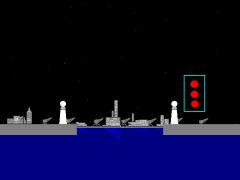
What is the meaning of the light signal being shown?
(1) Vessels shall NOT proceed. (2) Vessels shall NOT proceed except if navigating outside the main channel. (3) A vessel may only proceed when given a specific order. (4) Vessels may proceed. TWO WAY TRAFFIC. |
1
|
|
|
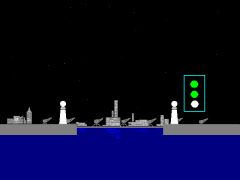
What is the meaning of the light signal being shown?
(1) Vessel may proceed. TWO WAY TRAFFIC. (2) Vessel may proceed. ONE WAY TRAFFIC. (3) Vessel shall NOT proceed. (4) Vessel shall NOT proceed except if navigating outside the main channel. |
1
|
|
|
|
At the commencement of a sea voyage the Master, a Pilot, the OOW and 2 ratings are present on the bridge. Who is in charge?
(1) The Master can designate either the Pilot or the OOW to be in charge (2) Always the Master (3) Always the Pilot whenever he is on board (4) Either the Pilot or the Master in accordance with the owner's instructions |
2
|
|
|
|
What is the best way to monitor the risk of collision in poor visibility?
(1) Post an extra lookout. (2) Monitor the radar display and post a lookout. (3) Take more satellite fixes.. (4) Arrange for hand steering. |
2
|
|
|
|
When out of sight of land, what is the principal threat to the ship?
(1) To have an engine breakdown which requires assistance (2) To have a collision with another ship (3) To end up on the wrong course and, as a result, consuming to much fuel (4) To be late due to bad weather |
2
|
|
|
|
Who has the responsibility for the watch during a sea voyage if the master comes on to the bridge?
(1) The master automatically assumes the responsibility for the watch (2) The master can only take over the watch responsibility if he tells the OOW that he is taking over (3) The master and the OOW will share the responsibility whenever the master is on the bridge (4) The two persons shall consult each other as required |
2
|
|
|
|
You need to anchor a ship in 80 meters of open water. How much chain should you use?
(1) 6 shackles. (2) 11 shackles. (3) 8 shackles. (4) 5 shackles. |
2
|
|
|
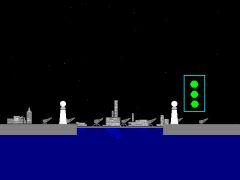
What is the meaning of the light signal being shown?
(1) A vessel may only proceed when given a specific order, except those navigating outside the main channel. (2) A vessel may proceed. One way traffic. (3) A vessel may proceed. Two way traffic. (4) A vessel may only proceed when given a specific order. |
2
|
|
|
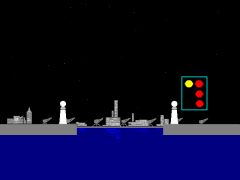
What is the meaning of the light signal being shown?
(1) Vessel shall NOT proceed. (2) Vessel shall NOT proceed except if navigating outside the main channel. (3) Vessel may proceed. ONE WAY TRAFFIC. (4) A vessel may only proceed when given a specific order, except those navigating outside the main channel. |
2
|
|
|
|
Apart from ensuring navigational safety at anchorage, what should the OOW do?
(1) Have all bridge equipment cleaned. (2) Check that the engineer on watch is in the engine room. (3) Monitor the VHF for orders for the vessel. (4) Direct the lookout to do maintenance work. |
3
|
|
|
|
How often should a position fix be taken during a sea voyage if the ship is in open coastal waters?
(1) Just before the change of watch (2) Twice a watch (3) At least every 30 minutes (4) Only when the visibility drops |
3
|
|
|
|
How should the anchor be positioned when a ship is due to anchor in a river with a strong current?
(1) It should be properly secured to prevent damage.. (2) It should be lowered to just below the water level. (3) It should be lowered to just above the water level. (4) It should be ready to drop at any time from it's normal secured position. |
3
|
Lowered to the water level so when the brake is released the anchor cable will run free at a very short notice.
|
|
|
The captain of a vessel has 2 years of experience as a captain and the pilot directing the navigation has 20 years of experience. Who is in charge ?
(1) Always the officer with the longest sea experience (2) The Pilot (3) The master (4) Depends on Port Authority's decision |
3
|
|
|
|
The pilot gives the helmsman an order which the OOW believe to be incorrect. What should he do?
(1) Record it in the log book (2) The pilot is in control of the vessel so he cannot question the action of the pilot (3) Ask the pilot to clarify the reason for the order. If still in doubt he should consult the master and take action if the master is not present (4) Keep quiet in order not to disturb the pilot |
3
|
|
|
|
What is a pilot boarding card?
(1) A card certifying that the pilot is licensed (2) A card that the pilot should sign to record his presence onboard (3) A list of the vessel's essential particulars which is given to the pilot (4) A card given by the Port Authorities to the pilot |
3
|
|
|
|
What is the duty of a pilot?
(1) To be responsible for the vessel's navigation as long as he is on board (2) To assist in planning the sea voyage (3) To direct the navigation of the ship in a certain area (4) To relieve the OOW of his duty to monitor the navigation of the ship |
3
|
|
|
|
When at anchor, what should the OOW do if the vessel appears to be dragging her anchor?
(1) Ask the chief engineer to start the engine (2) Ask the bosun to check the anchor (3) Call the master at once (4) Any of the other options |
3
|
|
|
|
When told to rig a pilot ladder, which side do you choose?
(1) The weather side (2) Close to the stern (3) The lee side (4) Either side |
3
|
|
|
|
Which of the listed tasks have priority over the other?
(1) Maintaining the track comes before collision avoidance (2) Navigating comes before controlling the vessel's track (3) Collision avoidance comes before maintaining course and track (4) The master decides which task has preference |
3
|
|
|
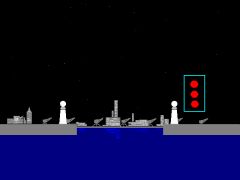
What is the meaning of the light signal being shown?
(1) A vessel may only proceed when given a specific order. (2) A vessel may proceed. TWO WAY TRAFFIC. (3) EMERGENCY - All vessels to stop or divert according to instructions. (4) Vessel may proceed. ONE WAY TRAFFIC. |
3
|
|
|
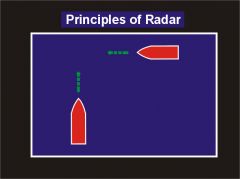
The International Regulations for Prevention of Collision at Sea includes......
(1) instructions for the use of the radio in fog. (2) instructions for keeping the radar log. (3) instructions on action to take while plotting a ship by radar. (4) rules for the proper use of navigational aids. |
3
|
|
|
|
An OOW, on duty in coastal waters, notices that he becomes too busy to be able to take a fix. What should he do?
(1) Slow down the vessel (2) Leave the fix until later (3) Ask the lookout to check for other vessels while he takes a fix (4) Call the master to assist him |
4
|
|
|
|
Should the OOW, who is escorting the pilot to the pilot ladder, be equipped with a walkie-talkie for communication with the bridge?
(1) It's not necessary (2) Yes, but only if visibility is restricted (3) It's up to the pilot to decide (4) Always |
4
|
|
|
|
The OOW has, during the pre-departure check of the bridge equipment, found an error in the weather facsimile. What should he do?
(1) Record the error in the log book (2) Advise the master after the vessel has departed (3) Call the attention of the 2nd Engineer on the fault (4) Advise the master as soon as possible before the vessel's departure |
4
|
|
|
|
Two ships approach each other on reciprocal courses, one with a speed of 22 knots, the other with 15 knots. What is their relative speed?
(1) 22 knots (2) 15 knots (3) 7 knots (4) 37 knots |
4
|
|
|
|
What is a safe interval between position fixes?
(1) Before the vessel is due to alter course (2) When the weather changes (3) So that the vessel cannot be set into danger if the last two fixes were incorrect (4) So that the vessel cannot be set appreciably off course, or into danger by the effects of wind, tide or current |
4
|
|
|
|
Which of following items should be checked before a ship sails?
(1) That cargo is stowed safely (2) That all moveable objects are secured (3) All bridge equipment, main engine, auxiliary systems and the steering system (4) All of the other options |
4
|
|
|
|
Why is it important for the OOW to move around the bridge?
(1) To be able to view all the instruments on the bridge (2) To be able to see what the lookout is doing (3) To be able to check the fire alarm system frequently (4) To be able to obtain a clear view of the surrounding area |
4
|
|
|
|
Will snow fall reduce the ability of the radar to detect targets?
(1) No. (2) Yes, but only with 'S' band radars. (3) Yes, but only with old radars which do not have a visibility compensator. (4) Yes. |
4
|
|
|
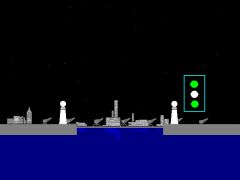
What is the meaning of the light signal being shown?
(1) Vessel shall NOT proceed. (2) EMERGENCY - All vessels to stop or divert according to instructions. (3) A vessel may only proceed when given a specific order, except if navigating outside the main channel. (4) A vessel may only proceed when given a specific order. |
4
|
|
|
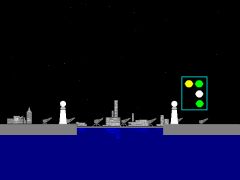
What is the meaning of the light signal being shown?
(1) Vessel shall NOT proceed. (2) Vessel may proceed. TWO WAY TRAFFIC. (3) EMERGENCY - All vessels to stop or divert according to instructions. (4) A vessel may only proceed when given a specific order, except if navigating outside the main channel. |
4
|
|

